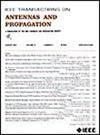基于间隙波导技术的毫米波宽带旋转接头和360°波束导向Rotenna设计
IF 4.6
1区 计算机科学
Q1 ENGINEERING, ELECTRICAL & ELECTRONIC
引用次数: 0
摘要
这项工作介绍了基于槽隙波导的旋转接头和用于宽带毫米波(mmWave)应用的360°机械波束转向的旋转天线(旋转天线)的设计和制造。所提出的旋转接头包含两个WR-22到槽隙波导转换,与一个创新的变压器背靠背连接。间隙波导技术的一个关键优势是它能够在旋转接头组件之间没有物理接触的情况下工作,允许转子在具有气隙的定子附近自由旋转,同时抑制波泄漏。通过用标准波导法兰代替普通同轴连接器,并在转子和定子之间引入一种新型变压器,我们成功地开发了一种适用于毫米波的宽带旋转接头。为了证明这一概念的实际适用性,我们设计了一个360°机械波束转向的旋转天线。该设计解决了电子操纵天线的常见限制,如有限的转向范围,增益下降,高成本和复杂性。为了验证这一概念,制作并测量了所提出的旋转接头和旋转天线的原型。实测结果与仿真结果吻合较好。旋转接头在35-55 GHz的频率范围内显示44.4%的分数带宽,插入损耗低于0.68 dB。此外,设计的rotena在360°转向范围内无扫描损耗,峰值实现增益为13 dBi。本文章由计算机程序翻译,如有差异,请以英文原文为准。
Design of mmWave Broadband Rotary Joint and 360° Beam-Steering Rotenna Based on Gap Waveguide Technology
This work presents the design and fabrication of a groove gap waveguide-based rotary joint and a rotenna (rotary antenna) with 360° mechanical beam steering for wideband millimeter-wave (mmWave) applications. The proposed rotary joint incorporates two WR-22 to groove gap waveguide transitions, connected back-to-back with an innovative transformer. A key advantage of gap waveguide technology is its ability to operate without physical contact between the rotary joint’s components, allowing the rotor to rotate freely near the stator with an air gap, while wave leakage is suppressed. By replacing common coaxial connectors with standard waveguide flanges and introducing a novel transformer between the rotor and stator, we have successfully developed a wideband rotary joint suitable for mmWaves. To demonstrate the practical applicability of this concept, we designed a rotenna with 360° mechanical beam steering. This design addresses the common limitations of electronically steerable antennas, such as limited steering range, gain degradation, and high cost and complexity. To validate the concept, the prototypes of the proposed rotary joint and rotenna were fabricated and measured. The measured and simulated results show good agreement. The rotary joint exhibits a 44.4% fractional bandwidth over the frequency range of 35–55 GHz with an insertion loss below 0.68 dB. Additionally, the engineered rotenna demonstrates a peak realized gain of 13 dBi with no scan loss over the full 360° steering range.
求助全文
通过发布文献求助,成功后即可免费获取论文全文。
去求助
来源期刊
CiteScore
10.40
自引率
28.10%
发文量
968
审稿时长
4.7 months
期刊介绍:
IEEE Transactions on Antennas and Propagation includes theoretical and experimental advances in antennas, including design and development, and in the propagation of electromagnetic waves, including scattering, diffraction, and interaction with continuous media; and applications pertaining to antennas and propagation, such as remote sensing, applied optics, and millimeter and submillimeter wave techniques

 求助内容:
求助内容: 应助结果提醒方式:
应助结果提醒方式:


